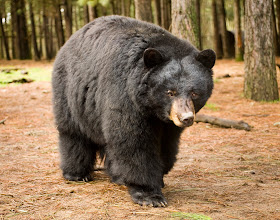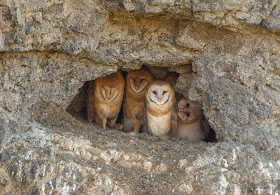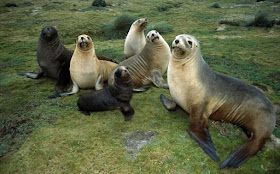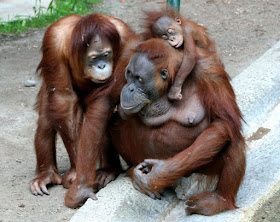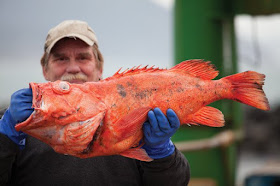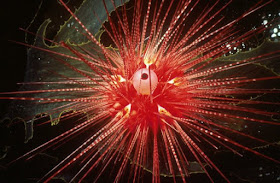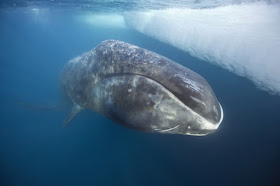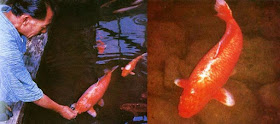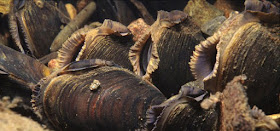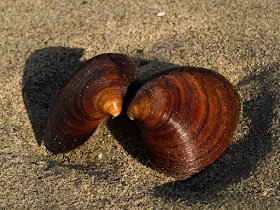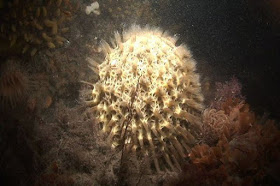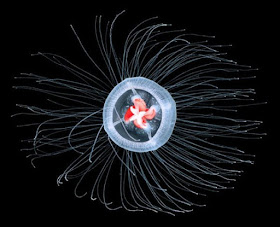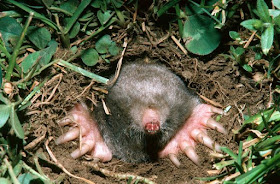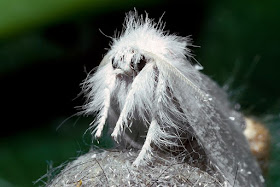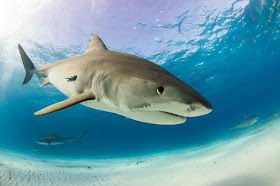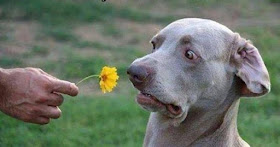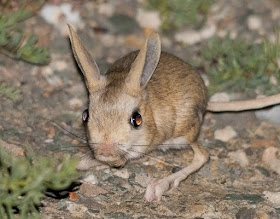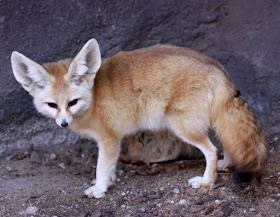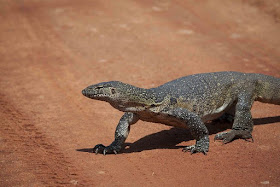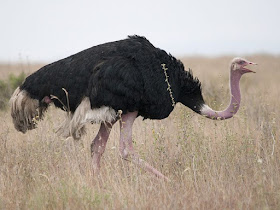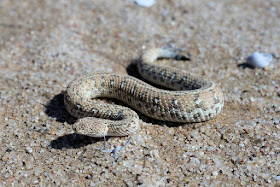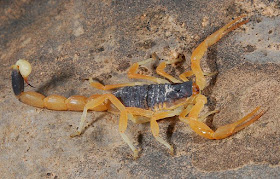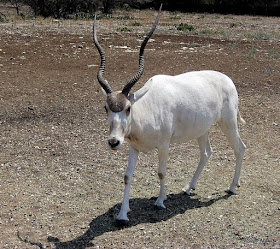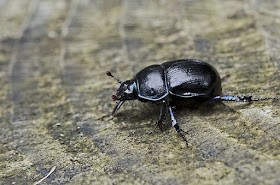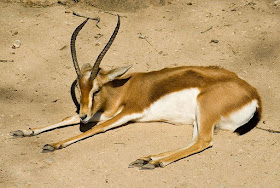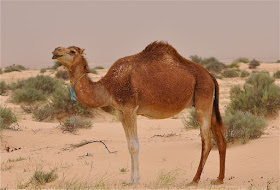Saturday, April 29, 2017
7 Animals That Smell Like Jelly Beans
So is this the zoo or a candy factory? Your nose can’t tell the difference. These seven animals are olfactory dead ringers for Jelly Belly flavors.
1. BINTURONG (ARCTICTIS BINTURONG) // BUTTERED POPCORN
The back end of the binturong, or bearcat, is legendary. Not for its size, shape, or productivity, but because it smells remarkably like a movie theater lobby. The heavenly scent that wafts across a bearcat habitat originates right in its inhabitants’ anal glands. Like housecats, binturongs are highly territorial and use smell to stake out their turf, but that’s where the similarity ends. While cats will snuggle and rub affectionately to leave their calling cards, a binturong scent-marks by dragging its butt across every object and surface it can find.
2. YELLOW ANTS (LASIUS INTERJECTUS) // LEMON DROP
The yellow ant is kind of a two-for-one deal. Not only do these ants emit an unmistakably lemony aroma, but they also look like little tiny lemons. Or their gasters (behinds) do, anyway.
When a colony of yellow ants is disturbed, its members emit a defensive chemical that smells so much like lemons that some people call these insects citronella ants. If your backyard smells suspiciously like a lemonade stand and there are no enterprising children in sight, take a look—you may have ants.
3. SPADEFOOT TOAD (SPEA MULTIPLICATA) // PEANUT BUTTER
Oh, spadefoot toad, you incredible weirdo. Behind your bulging eyes and claw-tipped hind legs is a gentle soul, a soul that craves solitude. A soul that enjoys a good wallow in the mud. A soul—and a parotoid gland—that will secrete a peanut butter-scented substance that causes sneezing and burning eyes in anyone who touches you. You just want to be left alone, spadefoot toad. We understand.
NOTE: We realize that Peanut Butter is no longer part of Jelly Belly’s 50 Official Flavors collection, but it remains lodged in our memories, our taste buds, and our hearts.
4. AFRICANIZED HONEYBEE (APIS MELLIFERA SCUTELLATA) // TOP BANANA
Their sting is bananas. B-A-N-A-N-A-S.
Let’s rewind a moment: Bee communication is super complex, and ranges from adorable folk dances to hysteria-inducing chemical signals like the alarm pheromone. When a forager bee feels threatened, it sends the scent of fear out into the hive. Other bees pick up the chemical trail and pass along the message, spreading panic. Africanized bees are both more sensitive to the pheromone than their European cousins and produce more of it, which means more panic, which means more stinging. And what does this alarm pheromone smell like to humans? You guessed it: bananas.
5. CRESTED AUKLET (AETHIA CRISTATELLA) // TANGERINE
So far we’ve seen nutty amphibians, citrusy insects, and buttery mammal butts, but what about fruit-fragranced birds? Yeah, we’ve got those, too.
Crested auklets are so fragrant, wildlife biologist Julie Hagelin told Nature, that “it’s like somebody is peeling a tangerine next to you.” The auklets are the first birds known to signal through scent. The seabirds use their oily bills to apply fragrance to their feathers like humans applying perfume, hoping to attract a mate. Smell is such a turn-on for these birds that their greetings consist of sniffing each other’s neck feathers. Toucan Sam could not be reached for comment.
6. GIANT MILLIPEDE (APHELORIA VIRGINIENSIS) // CHERRY COLA
Giant millipedes are kind of scary. They are, as their name suggests, pretty big—some species can be more than 15 inches long—and they brew all manner of poisons when they’re upset. The American giant millipede (Narceus americanus) secretes a liquid that can cause dermatological burns. But maybe these bugs have a bad name. Sure, Apheloria virginiensis may release cyanide when it’s stressed, but it also “has a nice odor, like cherry cola.”
Again: we’ve strayed from the Jelly Belly top 50, but hear us out. Cherry cola jelly beans, while retired from the American J.B. roster, are still a thing in the UK.
7. BEAVER (GENUS CASTOR) // FRENCH VANILLA
In the science world, the vanilla-scented, molasses-like goo that comes out of a beaver’s butt is known as castoreum. In the world of food science, it’s known as “natural flavoring.” When the news hit a few years back that beaver bum-milk was a legal food additive, consumers hit the fan. Fortunately, milking a beaver bottom is a thankless job and the yield is low, which means that most food-grade vanilla flavoring comes from less extreme sources.
Friday, April 28, 2017
American Black Bear
The American Black Bear, like most bears, lack the distinctive shoulder hump that the Grizzly Bear has. This bear can run up to 25 miles per hour, which is very quick for its 220-594 pound body. Their feet relate to humans, because they touch the ground in a "heel, toe, heel, toe, etc." pattern. They have rounded ears, a short stubby tail, and short claws that are useful in climbing trees. The American Black Bear is usually black but can have phases of brown,
cinnamon, beige and even a bluish- white. The length of this bear's body is usually 5-6 feet from nose to tail and 32-38 inches from paw to the top of its shoulder. They live in most of North America.
The female black bear reaches sexual maturity 4-5 years after birth, while the male reaches maturity 5-6 years after birth, they usually have 2 or 3 young. Their mating season is in the summer and they will give birth to their young in January or February. The cubs are blind at birth and weigh 8_ ounces to 11_ ounces. The males do not help raise the cubs, but leave to mate again like most other bear species. The Mother bear can be quite territorial if it involves her cubs. For example, if any animal gets between she and her cubs, she will relentlessly attack it until it is dead. The average black bear lives up 25 years.
The black bear's coat is well adapted to the cold weather of winter because of its many layers of shaggy fur. Its claws are also very adapted to its environment, this is because they are just the right length to climb the many trees that surround its forest home. This bear also hibernates to avoid having to find food in the winter.
Like most animals the Black Bear looks for food with the highest nutritional value. They will eat virtually anything, but 75% of its diet is made up plants and other vegetation, while the other 25% is made up of, carcasses, honey, small mammals and insects.
The black bear, like all bears, is a predator, and an omnivore. The black bear helps the environment by killing off the elderly, and weaklings of over populated prey. The black bear is not endangered and is widely distributed throughout most of North America.
Thursday, April 27, 2017
5 animals that are better parents than humans
Humans have protected animals, killed them, caged them, freed them, loved them and hated them...and now parents can learn a thing or two from them. Here are five ways animals are better parents than some humans:
1. Barn Owls
Humans can learn faithfulness from barn owls because these owls mate for life. If one dies their mate often dies soon after, unless there are little owlets to take care of. The male always provides food and protection for his mate untill his owlets are born. When the eggs hatch, the male makes it possible for his mate to focus her energy on teaching the little owls how to survive. Male and female barn owls will hunt for their owelts together once their little babies are able to be left in the nest.
2. Elephants
These majestic creatures don't often have babies, but when they do the calf is well protected. Protection is important for these mothers, and the entire herd. Occasionally, another herd will steal a calf but when this happens the original herd will all attack the calf theives and get the child back to its mother. This protection is important lesson for human parents; Let your community help protect you and your child and do the same for others.
3. Seals
Seals are adorable to watch and the way they teach their children to survive is amazing. Not only do they begin teaching survival techniques while their pups are young, seal parents protect their pups fiercely. It is a difficult balance to keep their pups safe while teaching them to survive, but somehow they manage. From seals, human parents can learn how to keep their kids safe, while still letting them experience life.
4. Orangutans
Orangutan mommies spend up to nine years in seclusion to teach their children how to feed and protect themselves and ensure mom and baby have a strong bond. When these orange cuties can't handle a danger themselves, they know mom will be there to protect them. That level of trust in a crisis is something all human parents should strive to have with their children.
5. Dolphins
I cannot talk about animal parents without mentioning playful dolphins. Dolphins have strong parental instincts - instincts that provide them extraordinary patience. Dolphin mothers will keep watch over her newborn calf for over a month, non-stop, without any sleep. They also patiently teach their calf how to swim, breath and survive the the ocean. But on top of all, dolphins also teach their young to be playful.
Humans do a great job raising our children (most of the time) but we could all use a little help learning faithfulness, protection, parent-child bonding, patience and playfulness...good thing we can learn from animals!
Thursday, April 20, 2017
10 Animals with Incredibly Long Lives
As medicine, society and science advance, our life expectancy continues to rise. More people are living to be over 100 years of age than ever before, diseases that were previously fatal are now nothing more than a nuisance, and with the advent of new technology, many people are hoping that they will be able to use technology to increase the length of their lives, or possibly even live forever as a computer. But while we think it’s great to live to be 90, some of the animal kingdom are laughing in our baby faces. Below are ten animals that put human birthday cakes to shame.
10. Rougheye Rockfish
While the Rougheye rockfish (Sebastes aleutianus) are generally considered to be amongst the longest living aquatic creatures, they barely come in last place here. They are generally found between 560 feet and 2,200 feet below sea level, often in the pacific ocean. They are so called because they can have ten spines along the lower rim of their eyes. The fish grow extremely slowly, mature late in life, and can live to be around 200 years old, with the oldest confirmed living to be 205.
9. Red Sea Urchins
The red sea urchin (Strongylocentrotus franciscanus) has been around for about 450 million years and is the largest of all sea urchins, being able to grow to about 10 inches across. They largely stay in the same place, which is why they are covered in protective spikes. However, sometimes they will group together, and swarm (read: crawl incredibly slowly) to find food. Although they don’t often live past 30 years of age, if they do, they can live to be over 200 years old.
8. Bowhead Whales
Some scientists believe that bowhead whales may be the oldest living mammals on earth. One whale in particular, Bada, is believed to have lived to be 211 years of age, but may have been as old as 245. Although most bowhead whales die between 20 and 60, 4 other bowheads were found to have been close to Bada in age, at 91, 135, 159 and 172. About 7 harpoon heads about that had been lodged in the whales for at least a century (although this is not how the whales get their name).
7. Koi Fish
The average age a koi fish will live to is under 50 years old, which isn’t bad. But it’s not nearly good enough to make this list. Hanako, however, was a koi fish who died in 1977, at the much more respectable age of 226 years old, meaning she was born in 1751. That means she was around before Benjamin Franklin discovered electricity, or before anybody knew mammoths had ever existed. It means she was alive for the signing of the declaration of independence, the French revolution, both world wars, and so on. Her age was determined by counting rings on her scales, much like determining the age of a tree.
6. Vestimentiferan Tubeworms
Vestimentiferan Tubeworms (Lamellibrachia luymesi) are sessile creatures, meaning they stay in one place for the entire of their adult lives. This particular species of tube worm is found mainly in the northern Gulf of Mexico. They live up to 2,500 feet below sea level in deep sea cold seeps. They have a symbiotic relationship with sulfide oxidizing bacteria, which is the sole source of their nutrition. They can grow up to 10 feet long, and can live in groups of thousands. Growing extremely slowly, these tube worms can live to be 250 years old.
5. Freshwater Pearl Mussels
It is thought that around 90% of the freshwater pearl (Margaritifera margaritifera) populations can be found around Scandinavia. They are generally very tough creatures that can adapt to new environments quite easily, so climate, geological, physical, biological or even chemical change won’t affect these creatures as much as others. But despite this, their numbers have been declining for many years now. Those that do survive are the toughest of the bunch, and have likely seen a great variety of ecosystems, as many of these mussels have been found to be over 250 years of age, making them possibly the oldest creatures in Europe.
4. Tortoise
Tortoises (Testudinidae) are famed for being long-lived. An average healthy tortoise could live to be about 150 years old, but this of course also depends on the type of tortoise in question. The oldest known tortoise, however, lived long past that. Adwaita was the pet of British General Robert Clive, before he was brought to a zoo in Kolkata (formerly Calcutta) where he spent the next 130 years of his life. It’s impressive enough in its on right that by the time Adwaita died, nobody working in the zoo was even born when he first arrived. His death was a result of a crack that developed in his shell, which was then carbon dated. Scientists placed his age at over 250 years old, many sources saying 255, others, 257.
3. Ocean Quahog
Ocean quahogs are a type of clam found mainly around the Scottish coast. Unsurprisingly, the generally don’t move much, burrow into sand or mud, using their gills to siphon in food and oxygen. To avoid being eaten, they can burrow deep into the seabed, and live there for extended periods of time without needing to come up for food or oxygen. Over the past few decades, ocean trawlers have resulted in their numbers being reduced by about 50% by either damaging the clams or leaving them vulnerable to predators. This will of course result in a lot fewer of them living to their full age. It’s not unusual for these animals to live to be over 400 years old, and one was even found that was 500 years of age.
2. Antarctic Sponge
Many people may not even realize that sponges are animals, but they are (otherwise how would Spongebob make any sense?). Obviously, sponges don’t do much, with some moving less than 1 millimeter a day, so it should come as no surprise that they grow excruciatingly slowly, like many of the other entries on this list. Their slow rate of growth results in them living such long lives. There are somewhere between 5 and 10 thousand species of sponge, with most of them living anywhere from 3 months to 20 years. The Antarctic sponge, on the other hand, lives much longer, with one specimen estimated to be a respectable 1,550 years old.
1. Jellyfish
This particular entry may not come as a surprise to some of you, as it has gained a lot of fame within the past year. And for good reason. To look at, the Turritopsis nutricula is nothing spectacular. Newborns are about 1mm, with 8 tentacles, while adults are about 4.5 with up to 90 tentacles. Originally from the Caribbean, these little tykes can now be found all over the world. But there is potential for trouble in the future, as they may just keep breeding and breeding. What makes them unique, not just among jellyfish, but all living things, is that they can revert back to sexual immaturity. The jellyfish are born, and grow like any other animal, but when they reach a certain age, they can revert back to the polyp stage and begin growing all over again. This would be like a 50 year old turning back into a baby. This means that these jellyfish are, potentially, immortal.
Wednesday, April 19, 2017
Top 10 Hybrid Animals
To get a hybrid animal, two animals from different species, but from the same genus, must be crossed. The resulting animal will be a hybrid. This does not happen very often in nature, and most hybrid animals are sterile, but imagine the possibilities.
10. Blood parrot cichlid
The blood parrot cichlid is a cichlid hybrid. It was created in Taiwan around 1986, and are produced by cross breeding a Midas cichlid with a Redhead cichlid or a Red devil cichlid. There is some controversy in the ethics when it comes to creating blood parrot cichlids, as they have several anatomical deformities, such as their mouth, which is only a small vertical opening and causes some to have difficulty feeding. Blood parrot cichlids are usually bright orange, but their color can vary to include red and yellow. Female blood parrots are usually fertile, whereas males are usually infertile, but there have been cases of successful breeding.
9. Zebroids
A Zebroid is the collective name for any zebra hybrids, and comes about when a male zebra is crossed with a female animal from the equidae family. These hybrids never occur in nature, and many zebroids can be born with a form of dwarfism and are almost always infertile. There are many different animals that would fall under the Zebroid group, including the Zorse (Zebra and a horse), Zonkey (zebra and donkey) and the zoni (zebra and pony). These remarkable animals usually have the build of the female animal, and the stripes of the male zebra, although the stripes never cover their whole bodies, and is usually limited to the feet and legs, or can be found in patches over the animals body
8. Dzo
The Dzo or yakow is a bovine Hybrid, and comes about from cross breeding a Yak with a domestic cow. The resulting animal is much larger than a cow or a yak, and is thought to be much more productive in milk and meat production. All the females born from this cross are fertile, and they can be bred back with either of the original species. The males born from this cross are always infertile. These animals where originally bred in Tibet and Mongolia as working animals, as they are a lot stronger than either of their parental counterparts.
7. Cama
The Cama was created in a laboratory in Dubai, and came from breeding a male Dromedary camel with a Lama. This animal was created with the purpose of making something with the size and strength of a camel, but with the easier temperament and higher wool production of the lama. Interestingly the cama are one of the few hybrids that are always fertile and this results from both the dromedary camel and the lama having the exact same amount of chromosomes. As the lama is six times smaller and lighter than a camel, the only way to obtain a cama is by artificial insemination, and there have only been about 6 successful cama births.
6. Grizzly-Polar bear
The Grizzly-polar bear or Grolar bear has been seen both in captivity and in the wild and there are reported sighting of these animals from as early as 1964. Polar bears and grizzly bears generally distance themselves from each other. The Grizzly likes forested areas and always breed on land, whereas polar bears like the water and ice and even gives birth on the ice. This fact made scientists come up with a theory that polar bears are being forced south as the polar ice caps melt, forcing them to the grizzly bears general territory. The grizzly-polar bear is a fertile hybrid, and there has even been a case of a second generation grizzly-polar bear that was shot on Victoria Island. After running DNA tests, it was established that the bear’s mother was a grizzly-polar bear and the father was a grizzly bear.
5. Coywolf
The Coywolf is essentially a Coyote and a wolf hybrid, that regularly occurs in nature. So regular, in fact, that all known red wolves have been found to have coyote genes in their lineage. It is not clear whether this inbreeding has occurred as a result of Human development limiting their natural habitat, or if the Red wolf has just always been a hybrid. This animal has caused a lot of problems in the Canid taxonomy, as hybrids are not usually referred to as a different species, though convention would call the red wolf a sub species of the wolf, leaving its Latin name without a mention of its coyote genes.
4. Savannah cat
The Savannah is a fairly modern domestic cat creation that was accepted as a new breed in 2001, by the International Cat Association. This cat is a hybrid of the domestic cat and the wild African Serval. Savannah’s are a lot more social than most domestic cat breeds, and have often been compared to dogs because of their extreme loyalty. The Savannah is a large cat with a very slim body. They are the highest jumpers, and the tallest cats in the cat world. Savannah’s can come in almost all colors, depending on what domestic cat was bred with the serval, they will always, however, have that spotted or marbled appearance. Depending on what generation hybrid the savannah is, will determine how wild and large the cat appears, and they often look very similar to a miniature version of a cheetah.
3. Wholphin
The wholphin is an amazing “under the sea” hybrid that comes from a bottlenose dolphin having a successful pregnancy from a false killer whale. As its name states, the false killer whale is not a whale, but a very large breed of dolphin. These remarkable animals have been known to occur in the wild, but so far there are only two living examples of wholphins in captivity, and they both call the Sea Life Park in Hawaii home. Kekaimalu was the first wholphin at Sea Life Park, and she proved to be fertile, when she gave birth at a younge age. Unfortunately, that first baby wholphin did not survive for long, and neither did the next baby she had, but luckily the third baby did. Her name is Kawili Kai and she became as large as a full grown bottlenose dolphin within two months of her birth. She now lives happily with her wholphin mom and bottlenose dad at the Sea Life Park.
2. Killer bees
Killer bees, or Africanized honey bees, are hybrid mistakes. They first came to being in 1957, when a replacement bee keeper accidentally released 26 Tanzanian queen bees in between the rest of the bee hives, on a farm in South Eastern Brazil. The hives had belonged to biologist, Warwick E. Kerr, who had intended to interbreed European bees with Southern African bees, to create a strain of bees that would produce more honey and that would adapt better in tropical conditions than European bees. Since their release, the killer bees have multiplied and migrated. They can be found throughout South America and through most of North America, now. Africanized honey bees are highly aggressive, hence the name “killer bee”, and are known to move huge distances in massive swarms. When they are threatened in any way, they will attack, and their attacks came in large numbers. They will ruthlessly sting any threat to death, as happens to about two people a year in the US.
1. Liger
The Liger is a hybrid cross between a male lion and a female tiger, thus both its parents are from the Panthera genus, but from different species. Ligers are the biggest of all the big cats, growing to almost the lion and tigers combined size. They carry characteristics from both parents, for instance their love of swimming from tigers and their highly social behavior from lions. Nowadays, Ligers can only be found in captivity as their territories don’t overlap, but in history there have been stories of ligers found in the wild. Ligers were long thought to be sterile, but this theory was disproved in 1953, when a 15 year old liger was successfully mated with a male lion. The cub survived into adulthood, despite having poor health.
At Jungle Island, a theme park in Miami, you can see Hercules. Hercules is a huge liger, with a weight reaching over 410Kg. Hercules holds the Guinness World record for being the largest big cat in the world. He is very healthy and is expected to live a long and happy life.
Tuesday, April 18, 2017
5 Animals With An Extraordinary Sense Of Smell
Albatross
Find Schools of Fish
The albatross can smell fish from the air. Researchers have found that an albatross will alter its course toward prey located well out of visual range. The birds can monitor a miles-wide swath of ocean as they fly in a single direction.
Eastern American Mole
Smell In Stereo
Scientists recently discovered that the Eastern American mole smells in stereo. Because they're blind and have little use for hearing, moles use stereoscopic smell to determine their location and the location of their prey.
Moths
Locate A Distant Mate
Moths don't have noses. Instead, they have antennae covered in scent receptors. While they don't detect every scent well, male silkworm moths can sense a single molecule of female sex hormone from at least a mile away.
Sharks
Detect Specific Proteins
Sharks breathe with their gills, so their noses serve only to smell. They are particularly well tuned for hunting. Sharks can sense a prey's amino acids at concentrations as low as one part per billion.
Dogs
Target a Single Scent
Dogs have a keen ability to discriminate among smells. An Auburn tracking dog can follow a single human trail, laid more than 24 hours before, across a campus crisscrossed by tens of thousands of students.
Monday, April 17, 2017
5 Animals that Might Show Up in Your Toilet
The critters on this list might convince you to keep the toilet seat down and your bathroom door closed—and, most of all, to look before you sit.
1. SNAKES
Last night, San Diego's Department of Animal Services removed a 5.5-foot-long Columbia rainbow boa (above) from a toilet in an office building. Stephanie Lacsa, co-founder of Vertical PR + Marketing, noticed a higher than normal level of water in the bowl and, when she began to plunge it, the snake popped out. “I thought my eyes were deceiving me,” Lasca said. “This is every person’s worst nightmare.”
Officials believe the snake Lasca found didn't come in through the toilet, but was instead left there by someone. Still, snakes seem to pop up in toilets fairly often: An Isreali man was bitten on the penis by a snake in his toilet; a Staten Island man was brushing his teeth when he saw a California kingsnake in his toilet bowl; a Mumbai family discovered a 6-foot cobra in their toilet, mere moments after someone had used it; a Pennsylvania woman found a black snake in her commode; a construction worker in Alabama stumbled upon a snake in his office bathroom; and so on.
2. RATS
It’s no urban legend: Rats can totally crawl up into your toilet bowl (here’s how they do it). Just ask the couple in South London who were afraid to go to the bathroom after a rat kept poking its head into their toilet bowl for 8 months, or the Brooklyn residents who were watching TV when a rat entered their apartment through the toilet, or the many people who have posted videos of rats in their toilets on YouTube. “It happens all the time, especially if you live in the basement or a first floor apartment,” Eddie Marco of Brooklyn Pest Control told Gothamist. “The pipe is empty, the rat crawls through the pipe and up over the hump and into the porcelain. And he can’t get back out.” Vector control in Portland, Oregon reportedly receives 10 to 15 calls a year from residents who have found rats, alive and dead, in their toilets. Marco’s advice: If you find a rat in your toilet bowl, flush it down—and if it gets into your apartment, call the experts to deal with it.
3. FROGS
It’s less scary than finding a snake or rat, but it’s probably still pretty disconcerting see a frog hanging out in your toilet bowl. It happens to lots of people: Googling “frog in toilet” yields nearly 1.2 million results. One Florida resident found enough frogs in his toilet that he wrote in to the Tampa Bay Times for advice: “How does a frog (of a pretty good size) get in the toilet? We had one a number of years ago and then again just Sunday.” The newspaper recommended putting a mesh screen over the toilet vent and keeping lights off at night (keeping them on would attract bugs and, therefore, potentially frogs).
4. SQUIRRELS
Rats aren’t the only rodents to pop up in toilet bowls. In 2008, a writer for Tallahassee magazine recounted what happened when her cats tipped her off to a squirrel in the toilet, and in 2010, a woman in Edmond, Oklahoma, discovered a squirrel splashing around in the bowl. It took two officers several minutes to “apprehend” the creature—which jumped out of the toilet and ran around the bathroom—and release it in a local park. And in 2013, Winnipeg resident Angela Campbell heard loud sounds coming from her toilet. “I was envisioning ... monsters,” she told the Winnipeg Free Press. Instead, she found a very smelly squirrel, “caked with whatever was inside the pipes, from wherever it was coming from.” Campbell didn’t freak out, though; instead, she removed the sad, weak little squirrel, cleaned it up in her bathtub, and set it free.
5. POSSUM
It appears that, in addition to playing dead, some possums enjoy taking a swim. In 2008, Brisbane, Australia resident Tim Fraser was doing the laundry in his bathroom when the water in the toilet began to gurgle—and out popped a baby possum. "It was like the toilet had given birth," Fraser told the Sydney Morning Herald. In 2011, Austin, Texas photographer Shaylan Nelson’s husband found what he thought was a baby rat, but was actually an adorable baby possum, in their toilet; they rescued the little guy and set him free. And in 2013, West Virginia writer Karin Fuller recounted the tale of finding a dead possum in her toilet—which, depending on your point of view, might be worse than a live possum.
Sunday, April 16, 2017
10 Incredibly Adaptive Sahara Desert Animals
When you think of a desert, do you imagine a lifeless wasteland where nothing can survive? While many people think of deserts as lifeless locations, they are actually quite diverse and rich in life.
In fact, it could be said that there is no finer example of the richness of evolution than a desert ecology. Why? The harsh conditions imposed by the desert climate force desert inhabitants to adapt. The fact that many species of plants and animals thrive even in these conditions is a great testament to the resourcefulness of life. Here are some amazingly adaptive Sahara desert animals.
10. Jerboa
These adorable little rodents have very long legs and can jump very high. Despite their minuteness, they can run up to 16 miles per hour, making them quite challenging to catch. Amazingly, the jerboa doesn’t have to drink water—quite a useful adaptation for a desert creature. It still needs to take in water of course, like all living things, but it is able to extract enough from its foods to sufficed for its needs.
9. Fennec Fox
These foxes are nocturnal and are characterized by their very large ears. Not only do the ears help them to hear better in the desert, but they also help them to release body heat, keeping them cool. They are small and lightweight, usually weighing only a couple of pounds.
8. Monitor Lizard
This large lizard (generally; some can be quite small) is venomous and can become quite aggressive when threatened, especially during colder seasons. Monitor lizards not only include desert-thriving species in the Sahara, but also species which can live in forests or even wetlands. This makes them some of the most versatile creatures on the planet. They are extremely intelligent and can even count.
7. Ostrich
Not a lot of people think of ostriches when asked to name a desert animal, but ostriches are some of the fastest animals in the Sahara. They are able to run up to 40 miles an hour, almost as fast as the gazelles. They can travel a long ways, and can also pick up noises and see movement across vast distances, helping them spot and avoid predators. When threatened, the ostrich can fight back, kicking with its long legs.
6. Sidewinder
There are a number of species of sidewinder in various deserts around the world. The horned viper is particularly well known in the Sahara. The venom from this snake can be lethal, and also quite painful, even in cases that do not lead to death. The unique sideways movement of the sidewinder helps it to traverse the sands quickly and effectively. Sadly, changes in the environment have caused the horned viper to enter the endangered species list.
5. Death Stalker Scorpion
This type of scorpion is translucent and yellow in appearance, and is among the most venomous animals of the Sahara desert, and the entire world. They look ephemeral and fragile, but they are incredibly dangerous, capable of causing respiratory failure and death.
4. Addax Antelope
Like the gazelle, the Addax antelope is well known for its sleekness and its beauty. They are among the most endangered animals on the planet, with long, elegant horns and flat feet. Sadly they have been hunted to the point where there are only around 500 left. Global warming has also done them no favors. They are however very good at crossing the Sahara sands on their flat feet. They will probably not be able to adapt to human threats and global warming fast enough to survive however, and need our help.
3. The Scarab Beetle
Also known by the less dignifying (but perhaps more descriptive) name “dung beetle,” the scarab beetle was a holy symbol to the ancient Egyptians and has some impressive adaptability. Dung beetles make creative use of animal feces. They are able to subsist almost entirely on animal waste. There are several ways that scarabs can make use of the dung they find, depending on how flexible they feel about their living situations. Dung beetles can roll dung until it makes a ball shape and then push it home, or simply dig a new burrow next to a heap of dung to live in. Some dung beetles just burrow into the dung they find and make it into a home, chewing their way out when they get hungry. Nom nom!
2. Dorcas Gazelle
Also known as the Ariel Gazelle, this animal is sleek and graceful, usually weighing around 25 kilograms. Many animals in the Sahara desert prey on gazelles, so the Dorcas gazelle has evolved to avoid them on impulse. When a predator approaches, the gazelle’s highly attuned body will automatically jump. This is known as “stotting.” It serves several purposes. Firstly, it gets the gazelle out of immediate danger. Secondly, it demonstrates the gazelle’s speed and reflexes to the predator, discouraging it. Thirdly, it alerts other gazelles that a predator is approaching. If the gazelle is forced to run, it can achieve an astounding 49 miles per hour.
1. Camels
One animal you probably think about when you think about the desert is the Sahara desert camel. Camels store a large amount of fat in the humps on top of their backs (no, not water—that is a myth). The fat can be burned for energy when the camel is unable to locate any food. While most of us are searching for ways to burn off fat and slim up our bodies, camels are actually evolved by nature to carry extra fat around to survive!
The Sahara desert really is quite diverse, and as you can see, some of the most incredible species on the planet make their home there. The conditions may be daunting, but the animals that live there are up for the challenge. Even in difficult conditions, life can prevail, which is really quite inspiring. Next time you’re going through a rough patch, think about the animals of the Sahara and how you can learn from their example.








